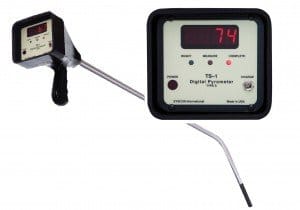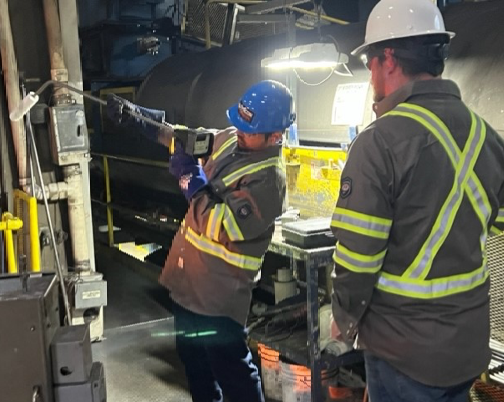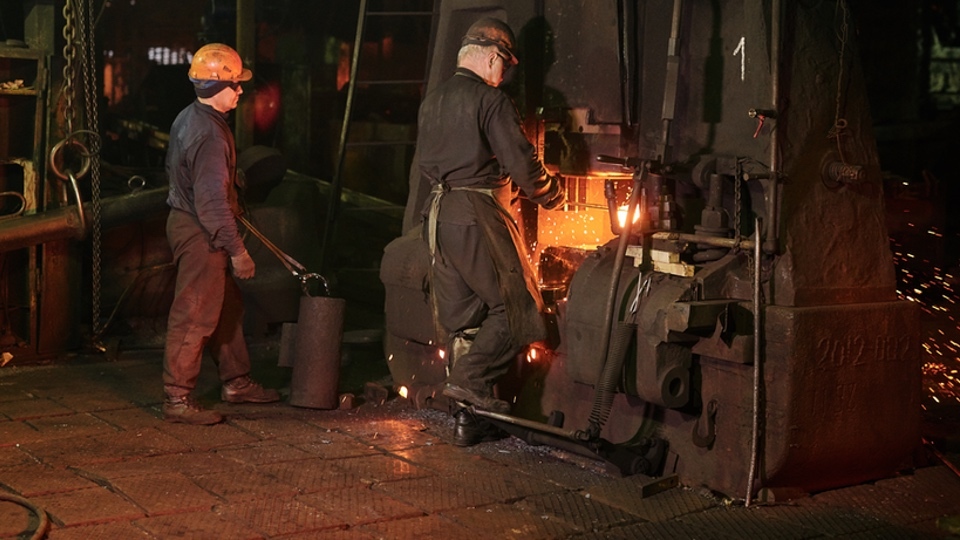
Thanks to modern advances in thermal technology, foundry operators – from steel mills to cast iron works – now have a wide range of solutions available when it comes to temperature measuring of molten metals. Accurate temperature data is vital across the entire molten metal process – temperatures that are too hot could damage molds while an overly low temp can lead to low fluidity, resulting in bubbles or cavities.
Using a precise tool to achieve detailed readings will improve product quality, optimize safety and reduce foundry downtime. As such, most foundries deploy a pyrometer to achieve exacting measurements.
Although there are a wide variety of types and sub-types, pyrometers are typically classified as contact or non-contact. Each have their appropriate use cases and their efficacy must be evaluated on a best use-case basis.
Contact Pyrometers and Thermocouple Tips
As the name implies, contact pyrometers require contact with the object being measured to obtain an accurate reading. Contact pyrometers can be handheld and portable or wall-mounted and fixed in place.
While there are a few different categories of sensors, most foundries use single- or multiple-use S or K type thermocouples because of their low cost and wide temperature range.
Thermocouples may be affected by several external factors during use, yielding less accurate readings. Ambient air temperature, thermal inertia, the probe’s thermal mass, surface oxidation and loss of heat via conduction all have the potential to produce suboptimal results.
In addition, repeated use can cause thermocouples to degrade or oxidize. However, due to lower costs, thermocouples are often the preferred sensor choice. Issues stemming from repeated use can be mitigated by using industry-leading products that are expendable, multi-use and non-splash while still retaining high-precision efficacy.
Users may choose thermocouple tip protected by ceramic fiber and foil insulation suited for larger furnaces, foundries and a wide range of molten metals - iron, steel, copper, bronze and aluminum. For small furnaces and ladles in slag-free metal, high-quality thermocouple tips protected by a quartz tube are often the better choice. Since only the quartz tube is dipped in molten metal, additional insulation is not needed.
Use Cases: Contact Pyrometers vs. Non-contact
Infrared (aka non-contact) pyrometers measure the amount of infrared radiation emanating from the object and infer the temperature by gauging the IR amplitude.
Depending on specific use cases, a contact pyrometer is often a better choice compared to non-contact infrared pyrometers.
Both types of pyrometers are deployed across several foundry/mill use cases: castings, rolling mills, heat treating, billets, dies/molds, bars/sheets and sheet metal – to name a few.
To properly determine the most appropriate type of pyrometer for a foundry, consider the following factors: the object’s temperature range, metal type/material, size, distance, slag or gaseous interference and ambient temperatures.
Once these factors are “dialed in,” it will quickly become apparent which type of pyrometer is necessary for the foundry or steel mill in question. While infrared pyrometers work well for measuring temperature of moving parts and/or solid materials, they only measure surface temperature. A contact pyrometer can be dipped into molten metal, thus obtaining a deeper data point and avoiding surface interference from slag or other factors.
In such a case, a contact pyrometer may more accurately gauge metallurgical temperatures. Pouring at the correct temperature ensures optimal fluidity and fill while minimizing shrinkage and related defects. A contact pyrometer can produce accurate temperature measurements precisely as a pour begins from the ladle without interference from slag, flames or molten drips.
When molten metal is poured into a mold, meticulously monitoring temperatures is paramount and must be maintained across the various locations of the foundry during the process. When properly used, a pyrometer will improve how a foundry operator evaluates the ladle’s outer shell. This will stop molten metal from breaking through the refractory lining.
Handheld Pyrometers: Use and Advantages
Since foundries require temperature measuring across different physical locations in the plant (for quality assurance), a handheld, portable digital pyrometer offers numerous advantages over wall-mounted/stationary products.
Digital pyrometers deploy a microprocessor that analyzes values, detecting the precise temperature of a molten metal source. Using a flat plateau detection method curtails problems such as slag temperature differentials, furnace hot spots, or transient electrical spikes.
When the thermocouple is dipped in molten metal, the microprocessor receives a millivolt signal from the thermocouple and mathematically converts it to provide the temperature reading. The indicator lamps (LEDs) on the front panel indicate and sound a buzzer when the correct reading is displayed. This entire process completes within 3 to 5 seconds, after which the thermocouple tip can be withdrawn. Thanks to the powerful microprocessor, accuracy is typically ±3°F from 400°F - 3300°F (±2°C from 205°C - 1815°C).
When used with a K-type probe, a digital pyrometer measures lower temperatures and may include Peak Hold/Track modes. Digital pyrometers can also be used with thermocouple tips – i.e. expendable temperature sensors in cardboard tubes.
In summary, digital pyrometers are used widely by ferrous foundries and steel plants and are generally available as a handheld or wall-mounted device. They can capture peak temperature in fewer than five seconds and can be used with molten steel, bronze, cast iron, aluminum alloys, copper, gold, brass, and silver when fitted with a handheld lance and appropriate thermocouple tip.
For more information about pyrometers and other common steel plant or foundry tools, subscribe to our blog!


